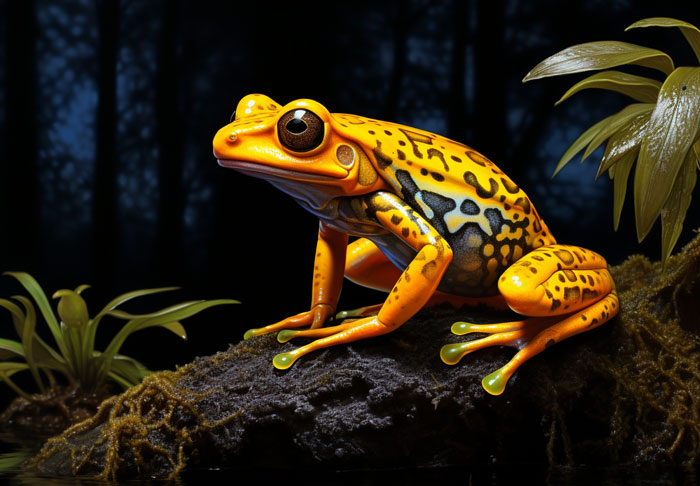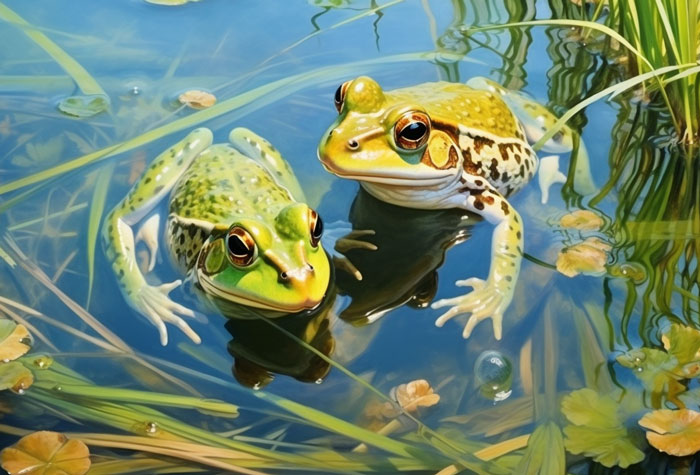Unlike humans, frogs rely heavily on the external environment. The external environment can cause significant genetic changes in a frog’s body.
But can frogs change gender? Yes, frogs can change gender and are hermaphrodites. In a population with a skewed male-female ratio, gender change can help maintain equilibrium. Additionally, agricultural chemicals such as atrazine can cause gender changes in frogs.
Not all frogs can change gender, though. Read on to find out which ones can and the process behind the transformation.
Can Frogs Change Gender? Are They Hermaphrodites
Yes, frogs can change their gender and are hermaphrodites. This sex-reversal process is called ‘sequential hermaphroditism.’ These frogs are born with dual reproductive organs that allow them to switch between genders.
At the larval stage, tadpoles can develop female ovaries. Eventually, they begin to develop predominantly male features and testes. This transitions them into becoming fully-grown male frogs.

However, those early female gonad cells survive in the frog’s body. These cells become dominant in the later stages of the frog’s life, causing sequential hermaphroditism.
Alternatively, unknown environmental conditions or chemicals could cause the frog to develop female cells amidst testicular development. Once frogs reach adulthood, they cannot develop cells of the opposite gender.
Around 2-16% of the observable frog population can change their genders. Besides frogs, butterflies, sea bass, humphead wrasse, hawkfish, cardinals, clownfish, banana slugs, and some invertebrate species are hermaphrodites.
Can All Frogs Change Their Gender?

No, all frogs cannot change their gender. Frogs that can change their gender (hermaphrodites) are listed below:
- African Clawed frogs
- Common Reed Frogs
- Green Tree Frog
- Red-eyed Tree Frog
- Leopard Frog
- Mexican-dwarf Frog
- Darwin’s Frog
- Common Coqui
- Madagascar Poison Frog
- Golden Poison Frog
- Haswell’s Frog
- Cricket Frog
- Wood Frog
Why Do Frogs Change Genders?

Frogs change their genders for the following reasons:
Facilitates Reproduction And Survival
When two frogs mate, they both insert their gamete into each other’s body. Since they are hermaphrodites, both are capable of laying eggs.
This boosts their genetic diversity, increases the frog’s population, and gets rid of bad mutations.
Another phenomenon was observed in African reed frogs. When the male-to-female ratio in a frog population is skewed, some frogs switch their gender to maintain equilibrium.
Consider an area that has too many males and not enough females. To compensate for the situation, some male frogs will become females.
Protrandy (male-to-female) is more common than protogyny (female-to-male). This is because protandry allows the frog to give birth and maximize the number of offspring.
In dry environments where there is a scarcity of food, changing from male to female increases the frog’s survival rate. It becomes easier to find a male counterpart who can help protect and ensure this frog’s survival.
Herbicide Effect
Every year, around 80 million pounds of herbicide atrazine are sprayed across the US to stop weeds and promote crop growth. It is the most widely used herbicide in America.
Atrazine has been proven to cause gonadal abnormalities and trigger hermaphroditism in frogs.
It contains estrogen-mimicking properties that disrupt hormone production and development in frogs. Tadpoles raised in atrazine-contaminated water develop both male and female gonads.
It can chemically castrate and feminize male frogs.
As little as 0.1 parts per billion of atrazine is enough to alter sexual development in frogs. One out of ten frogs exposed to atrazine will change their gender and emasculate three-fourths of the remaining frogs.
Other hormone-changing chemicals that are hazardous to frogs are PCB (polychlorinated biphenyls) and DDT (dichlorodiphenyltrichloroethane).
How Do Frogs Change Their Gender?

The process of female-to-male gender transition is as follows:
- The female frog is hormonally triggered for the reasons mentioned above.
- As a response, a key hormone called ‘gonadotropin-releasing hormone’ (GnRH) causes major changes in the endocrine system.
- Gradually, the female ovarian tissue begins transforming into testicular tissue.
- Once the testes are developed, the frog can produce sperm in addition to retaining her eggs.
- This hermaphrodite frog is now capable of impregnating other frogs or getting impregnated by another frog.
The male-to-female gender switch is as follows:
- The male frog is triggered due to the environment, population ratio circumstances, or atrazine properties.
- The GnRh hormone shrinks the testicular size and function in the endocrine system of the frog.
- Alternatively, atrazine may stimulate the production of aromatase protein that spurs estrogen growth.
- This promotes the development of ovarian tissues in favor of testicular tissues.
- Once the female gonads are fully functional, the frog can produce and lay eggs besides producing sperm.
- This hermaphrodite frog can now mate with either gender to expand its pool of genes.
Can Male Frogs Lay Eggs?
Male frogs can only lay eggs if they have developed fully functional female ovaries. If they just appear outwardly female without functioning female reproductive organs, they cannot lay eggs.
For example, atrazine can disturb the development of a frog’s reproductive organs. It can also hurt the development of a frog’s immune system.
This can prevent the female gonads from being fully functional. Such hermaphrodite frogs can mate with other male frogs but cannot lay eggs.

FAQs
The most frequently asked questions on this topic are mentioned below. These will help you to learn more things about frogs’ gender change.
No, hermaphrodite female frogs cannot reproduce without a male. Although they possess organs from both genders, they cannot produce on their own without a male.
It is reported that around 5% of animal species can change genders based on specific circumstances.
Changing gender is natural and common in frogs. The previously-held notion that only atrazine is the main unnatural cause of gender change in frogs has now been refuted.
Final Words
Sequential hermaphroditism is a natural process that occurs in frogs and many other amphibians, reptiles, and invertebrates. It gets triggered due to a specific need in the environment or atrazine present in the pond or land.
Hermaphrodite frogs can both impregnate or get impregnated by others. However, a male frog can only lay eggs if it has developed fully functional female ovaries.

Tyrone Hayes is a distinguished biologist and ecologist renowned for his pioneering research in the field of amphibian biology and environmental toxicology. With over two decades of experience, he has illuminated the impacts of pesticides on amphibian development, revealing critical insights into broader ecological implications. Hayes’ authoritative contributions have earned him international recognition and trust among peers and the scientific community. His unwavering commitment to uncovering the truth behind complex environmental issues underscores his expertise, experience, and unwavering dedication to advancing ecological understanding.
